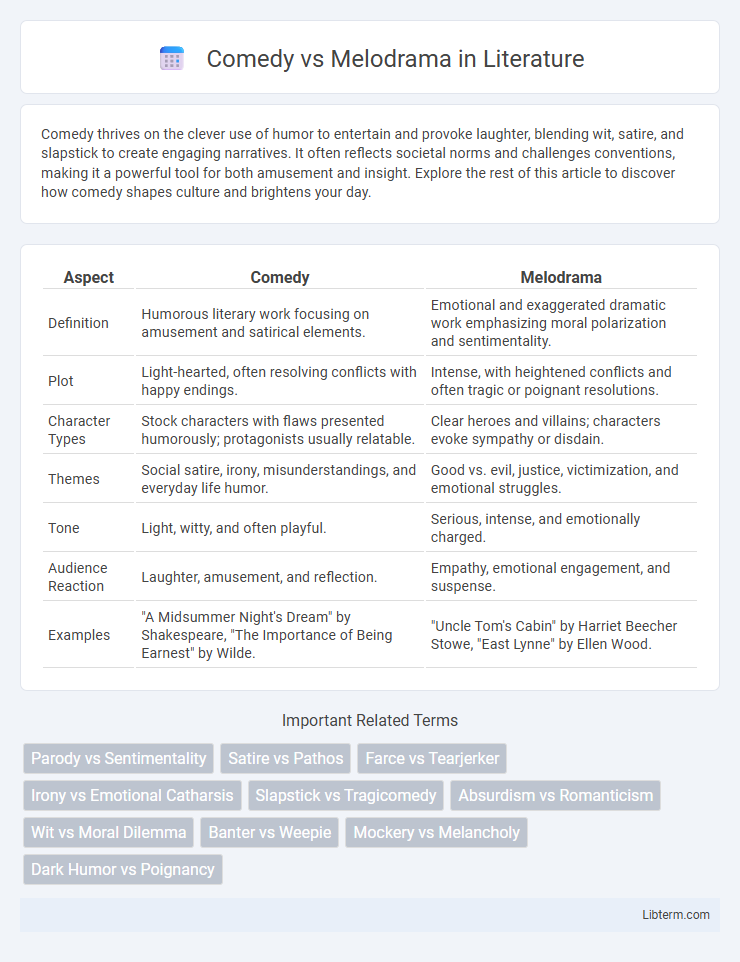Comedy thrives on the clever use of humor to entertain and provoke laughter, blending wit, satire, and slapstick to create engaging narratives. It often reflects societal norms and challenges conventions, making it a powerful tool for both amusement and insight. Explore the rest of this article to discover how comedy shapes culture and brightens your day.
Table of Comparison
| Aspect | Comedy | Melodrama |
|---|---|---|
| Definition | Humorous literary work focusing on amusement and satirical elements. | Emotional and exaggerated dramatic work emphasizing moral polarization and sentimentality. |
| Plot | Light-hearted, often resolving conflicts with happy endings. | Intense, with heightened conflicts and often tragic or poignant resolutions. |
| Character Types | Stock characters with flaws presented humorously; protagonists usually relatable. | Clear heroes and villains; characters evoke sympathy or disdain. |
| Themes | Social satire, irony, misunderstandings, and everyday life humor. | Good vs. evil, justice, victimization, and emotional struggles. |
| Tone | Light, witty, and often playful. | Serious, intense, and emotionally charged. |
| Audience Reaction | Laughter, amusement, and reflection. | Empathy, emotional engagement, and suspense. |
| Examples | "A Midsummer Night's Dream" by Shakespeare, "The Importance of Being Earnest" by Wilde. | "Uncle Tom's Cabin" by Harriet Beecher Stowe, "East Lynne" by Ellen Wood. |
Introduction to Comedy and Melodrama
Comedy and melodrama represent two foundational genres in dramatic storytelling, each with distinct emotional appeals and narrative structures. Comedy emphasizes humor and often features exaggerated characters and situations to provoke laughter and highlight social satire, while melodrama focuses on intense emotional conflicts, moral polarization, and sensational plots to evoke strong feelings of sympathy or outrage. Understanding the origins and characteristics of these genres enhances appreciation of their unique roles in theater, film, and literature.
Defining the Core Elements of Comedy
Comedy hinges on humor, wit, and the lighthearted exploration of human follies, often employing satire, irony, and exaggeration to provoke laughter and amusement. Key elements include character flaws, misunderstandings, and situational irony that create conflict resolved through humorous twists, thus fostering a sense of joy and relief. Unlike melodrama's intense emotion and moral polarization, comedy aims to entertain by highlighting the absurdities and imperfections of everyday life with playful, clever dialogue and timing.
Key Characteristics of Melodrama
Melodrama emphasizes exaggerated emotions, clear moral distinctions between heroes and villains, and dramatic plot twists designed to provoke intense audience reactions. Characters are often archetypal, with victims suffering injustice and villains embodying evil, reinforcing a sensational, emotionally charged atmosphere. The narrative typically relies on suspense, heightened stakes, and moral polarization to engage viewers on a visceral level.
Historical Evolution of Both Genres
Comedy and melodrama evolved distinctly through theatrical history, with comedy tracing back to ancient Greek festivals like Dionysia, emphasizing satire and social critique, while melodrama emerged in the 18th century, characterized by exaggerated characters and emotional appeal in response to Enlightenment rationalism. The 19th century marked a clear divergence as comedy adapted to modern social complexities and realism, whereas melodrama thrived on sensational plots and moral polarization, particularly in Victorian England and early American theatre. Technological advances in stagecraft and the rise of cinema further shaped both genres, with comedy integrating diverse narrative techniques and melodrama influencing film genres such as film noir and soap operas.
Emotional Impact: Laughter vs. Tears
Comedy elicits emotional impact primarily through laughter, using humor, wit, and situational irony to create joy and amusement in the audience. Melodrama drives strong emotional responses by evoking tears, employing exaggerated characters and intense conflicts to highlight moral struggles and human suffering. Both genres engage viewers deeply, but comedy soothes through levity while melodrama provokes empathy through emotional intensity.
Narrative Structure: Conflict and Resolution
Comedy narratives feature conflicts that often arise from misunderstandings or social mishaps, leading to humorous situations and ultimately a resolution that restores social harmony and happiness. Melodrama structures center on intense emotional conflicts, typically involving moral dilemmas or familial struggles, culminating in resolutions that emphasize emotional catharsis or justice. Both genres deploy conflict and resolution to engage audiences but diverge in tone and thematic emphasis, with comedy prioritizing laughter and reconciliation, while melodrama highlights emotional intensity and moral clarity.
Iconic Examples in Film and Theater
Iconic comedy examples include Shakespeare's *A Midsummer Night's Dream* and the film *Some Like It Hot*, both celebrated for their witty dialogue and humorous misunderstandings. Melodrama is epitomized by plays like *The Octoroon* and films such as *Gone with the Wind*, showcasing exaggerated characters and emotional plots designed to evoke intense audience reactions. These genres contrast sharply, with comedy focusing on satire and levity, while melodrama emphasizes heightened emotional stakes and moral polarization.
Audience Reception and Expectations
Comedy typically engages audiences through humor, light-hearted scenarios, and quick-paced dialogue, leading to expectations of entertainment and laughter. Melodrama appeals to emotional responses, emphasizing exaggerated characters and conflicts, which often results in heightened audience empathy and dramatic tension. Audience reception varies as comedy demands amusement and relief, whereas melodrama requires emotional investment and catharsis.
Blurring the Lines: Genre Hybrids
Comedy and melodrama often intersect in genre hybrids that blend humor with heightened emotional stakes, creating complex narratives that engage audiences on multiple levels. These hybrids exploit melodrama's intense character conflicts and exaggerations while infusing comedic relief through irony, satire, or absurdity, resulting in a nuanced tonal balance. Popular examples include dramedies and tragicomedies, which defy rigid genre classifications and reflect evolving storytelling trends in film and television.
Choosing the Right Genre for Storytelling
Choosing between comedy and melodrama depends on the emotional impact and narrative tone a storyteller aims to achieve. Comedy thrives on humor, wit, and lighthearted scenarios that entertain while often critiquing societal norms, making it ideal for uplifting and engaging audiences. Melodrama emphasizes exaggerated emotions and moral conflict, creating intense, dramatic experiences that highlight human struggles and evoke deep empathy.
Comedy Infographic

 libterm.com
libterm.com